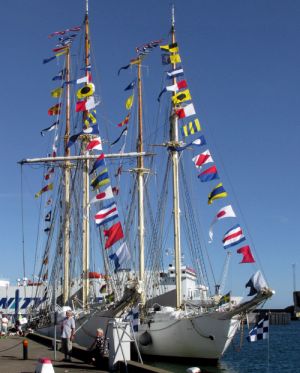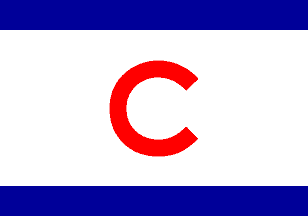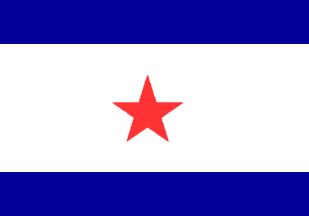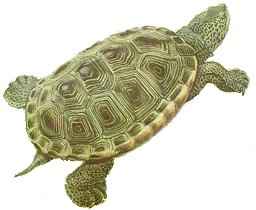Nautical Signal Flags

Alpha-Numeric Signal Flags
In this modern age of radio, these signal flags are a quaint anachronism that is no longer used, although they were once very important in ship-to-shore and ship-to-ship communications. Each flag stands for both a letter value and a shorthand message. The letters are expressed here in the modern international phonetic alphabet, in which A-B-C would be spoken Alpha-Bravo-Charlie (see below).
The letter and number values could be used in groups to spell out messages, or a single flag could be used to convey a message, such as the familiar blue-and-white diver-down flag - Alpha. You may notice that the red-and-white "diver down" flag is missing. That is because it is not one of the official signal flags, although it is accepted and required in the United States, where it must be flown along with the blue and white Alpha flag from any vessel engaged in diving.
The bright colors and highly contrasting patterns of the flags allowed them to be read over great distances at sea. Naval commanders in the seventeenth and eighteenth centuries used flag signaling to coordinate actions among ships during battle. Special codes such as "attack at will" or "fall in astern" could be pre-arranged for the whole fleet. During major battles, smaller vessels, often frigates, were kept outside the fray to act as repeaters, duplicating the admiral's signals aboard the flagship, which might be otherwise be obscured from the rest of the squadron by smoke. Signal flags were ultimately replaced by Morse code light signals and radio.
 Alpha Diver Down - Keep Clear or Speed Trial ( when moving ) |  Juliet I Am On Fire Keep Clear |  Romeo ( no meaning ) |
 Bravo Dangerous Cargo ( Explosives ) |  Kilo Stop Instantly |  Sierra Engines Going Full Astern |
 Charlie Yes |  Lima Desire to Communicate |  Tango Keep Clear Do Not pass |
 Delta Keep Clear Maneuvering with Difficulty |  Mike I Am Stopped Doctor On-board |  Uniform Standing into Danger |
 Echo Altering Course to Starboard |  November No |  Victor Require Assistance ( not distress ) |
 Foxtrot Disabled Please Communicate |  Oscar Man Overboard |  Whiskey I Require Medical Assistance |
 Golf Pilot Required |  Papa I Am About to Sail Need a Pilot |  X-ray Stop Your Intentions |
 Hotel Pilot on Board |  Quebec Quarantine Request Pratique * |  Yankee Dragging Anchor or Carrying Mail |
 India Altering Course to Port | * A pratique is a clearance granted to a vessel to proceed into port after compliance with health regulations or quarantine. |  Zulu I Require a Tug ( shore communications ) |
 One  Two  Three  Zero |  Four  Five  Six |  Seven  Eight  Nine ( spoken: niner )  Answer End of Message Decimal Point |
 First Repeater Repeat First Flag |  Second Repeater Repeat Second Flag |  Third Repeater Repeat Third Flag |
Semaphore

The semaphore flag signaling system is an alphabet signaling system based on the waving of a pair of hand-held flags in a particular pattern. The flags are usually square, red, and yellow, divided diagonally with the red portion in the upper hoist.

The flags are held, arms extended, in various positions representing each of the letters of the alphabet. The pattern resembles a clock face divided into eight positions: up, down, out, high, low, for each of the left and right hands. Six letters require a hand to be brought across the body so that both flags are on the same side. The entire sequence is shown below.

One way to visualize the semaphore alphabet is in terms of circles. In the first circle, the letters A to C are made with the right arm, and E to G with the left, and D with either as convenient. In the second circle, the right arm is kept still at the letter A position, and the left arm makes the movements; similarly, in the remaining circles, the right arm remains fixed while the left arm moves. The arms are kept straight when changing from one position to another. Semaphore was more a land-based system that signal flags.
| First Circle |
Seventh Circle |
||||
 A / 1 |
Second Circle |
 [ rest ] |
 [ error ] |
 Z |
|
 B / 2 |
 H / 8 |
Third Circle |
belongs next to X below |
||
 C / 3 |
 I / 9 |
 O |
Fourth Circle |
||
 D / 4 |
 K / 0 |
 P |
 T |
Fifth Circle |
|
 E / 5 |
 L |
 Q |
 U |
 [ numeric ] |
Sixth Circle |
 F / 6 |
 M |
 R |
 Y |
 J |
 W |
 G / 7 |
 N |
 S |
 [ annul ] |
 V |
 X |

Note that J is out of order, as are V, W, X, and Y. The intention seems to be to promote Y and [annul] to better spots in the sequence and demote the relatively unimportant letters. Z is in order at the end of the sequence, but is shown out of place here because of formatting constraints - it belongs at the lower right next to X. The J signal was also used as the [alphabetic] symbol. Positions having both flags in the same direction are not used. Semaphore has been replaced by radio communications, except perhaps in the Boy Scouts.
Morse Code
The earliest telecommunications device - the telegraph - was not capable of transmitting much more than noise. But even noise can be used to encode useful information, and so the Morse code signaling system was developed. Morse code consists of sequences of long and short bursts of static, or later, tones, commonly known as dots and dashes. When ships ( and airplanes ) were first equipped with radios, these were not much better than telegraph, incapable of transmitting voice, and so used Morse code.
Unlike signal flags and semaphore, which are strictly visual systems, Morse code is extremely flexible and can be used with many different transmission mechanisms. It can be sent down a wire or alternatively transmitted on the radio, or even by sound. Morse code can also be transmitted visually by means of flashing lights. This is still used today when ship-to-ship communications with radio silence are desired. Many modern radio navigation beacons transmit three-letter identification codes in Morse which can be monitored by audio to ascertain that the correct beacon has been tuned in the receiver. So unlike the previous two signaling systems, Morse code is far from dead.
| A B C D E F G H I J K L M | . - -. . . - . -. - . . . . . -. - - . . . . . . . . - - - - . - . - . . - - | N O P Q R S T U V W X Y Z | - . - - - . - -. - - . - . - . . . . - . . - . . . - . - - - . . - - . - - - - . . | 0 1 2 3 4 5 6 7 8 9 Full Stop Comma Query | - - - - - . - - - - . . - - - . . . - - . . . . - . . . . . - . . . . - - . . . - - - . . - - - - . . - . - . - - - . . - - . . - - . . |
Notice how the most-used letters ( a e i m n t ) have the simplest encodings, to speed transmission and reduce errors. All numbers consist of 5 bits, and punctuation is 6 bits.
... / -.-. / ..- / -... / .-
– . – – / – . – – / – – . .
Storm Warning Flags
These flags are flown at inlets, marinas, Coast Guard stations, and other port locations to indicate hazardous weather conditions. The meaning depends on whether the flags are flown singly or in pairs.
 Small Craft Warning Winds up to 38 mph   Gale Warning Winds 39-54 mph |  Full Gale Warning Winds 55-73 mph   Hurricane Warning Winds 74 mph + |
Unfortunately, there is no standardization in beach warning flags. Different colors indicate safe or hazardous surf, no swimming, no surfing, undertows, jellyfish, pollution, and other conditions, but the pattern varies from place to place.
Shipping Line Ensigns


Phonetic Alphabet
The phonetic alphabet was derived from previous US military alphabets, such as the Army's:
| Able Baker Charlie Dog Easy Fox | George How Item Jig King | Love Mike Nan Oboe Peter | Queen Roger Sugar Tare Uncle | Victor William X-ray Yoke Zebra |
The Navy and Air Corps substituted: Affirm, Hypo, Inter, Negat, Option, and Prep.
Numbers are spoken as usual, except for nine, which becomes "niner". The whole thing was standardized after World War II, but you may still run across the old forms in war films and histories. The modern phonetic alphabet is heavily used in aviation and marine radio communications:
| Alpha Bravo Charlie Delta Echo Foxtrot | Golf Hotel India Juliet Kilo | Lima Mike November Oscar Papa | Quebec Romeo Sierra Tango Uniform | Victor Whiskey X-ray Yankee Zulu |

So what does all this have to do with scuba diving? Not much, I guess, but I think it is interesting from a historical perspective, and it makes a nice colorful web page. I especially like the little semaphore guys waving their flags around. Your final exam is at right.
Vessel in Distress
 November |  Charlie |

